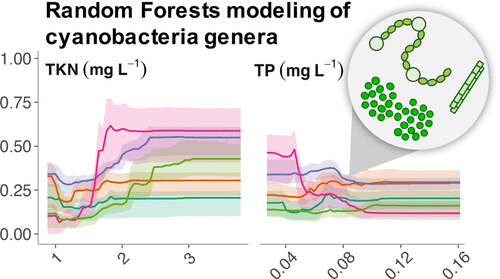当前位置:
X-MOL 学术
›
Environ. Sci. Technol.
›
论文详情
Our official English website, www.x-mol.net, welcomes your
feedback! (Note: you will need to create a separate account there.)
Revealing Biotic and Abiotic Controls of Harmful Algal Blooms in a Shallow Subtropical Lake through Statistical Machine Learning
Environmental Science & Technology ( IF 10.8 ) Pub Date : 2018-03-09 00:00:00 , DOI: 10.1021/acs.est.7b05884 Natalie G. Nelson 1, 2 , Rafael Muñoz-Carpena 1 , Edward J. Phlips 3 , David Kaplan 4 , Peter Sucsy 5 , John Hendrickson 5
Environmental Science & Technology ( IF 10.8 ) Pub Date : 2018-03-09 00:00:00 , DOI: 10.1021/acs.est.7b05884 Natalie G. Nelson 1, 2 , Rafael Muñoz-Carpena 1 , Edward J. Phlips 3 , David Kaplan 4 , Peter Sucsy 5 , John Hendrickson 5
Affiliation

|
Harmful algal blooms are a growing human and environmental health hazard globally. Eco-physiological diversity of the cyanobacteria genera that make up these blooms creates challenges for water managers tasked with controlling the intensity and frequency of blooms, particularly of harmful taxa (e.g., toxin producers, N2 fixers). Compounding these challenges is the ongoing debate over the efficacy of nutrient management strategies (phosphorus-only versus nitrogen and phosphorus), which increases decision-making uncertainty. To improve our understanding of how different cyanobacteria respond to nutrient levels and other biophysical factors, we analyzed a unique 17 year data set comprising monthly observations of cyanobacteria genera and zooplankton abundances, water quality, and flow in a bloom-impacted, subtropical, flow-through lake in Florida (United States). Using the Random Forests machine learning algorithm, an ensemble modeling approach, we characterized and quantified relationships among environmental conditions and five dominant cyanobacteria genera. Results highlighted nonlinear relationships and critical thresholds between cyanobacteria genera and environmental covariates, the potential for hydrology and temperature to limit the efficacy of cyanobacteria bloom management actions, and the importance of a dual nutrient management strategy for reducing bloom risk in the long term.
中文翻译:

通过统计机器学习揭示浅亚热带湖泊有害藻华的生物和非生物控制
有害的藻华在全球范围内正在对人类和环境健康构成日益严重的危害。组成这些水华的蓝细菌属的生态生理多样性给水管理人员带来了挑战,他们需要控制水华,特别是有害生物类别(例如,毒素生产者N 2)的强度和频率固定器)。养分管理策略(仅磷与氮和磷的对比)有效性的争论不断加剧,这增加了决策的不确定性。为了增进我们对不同蓝藻对营养水平和其他生物物理因素的反应的了解,我们分析了一个独特的17年数据集,其中包括对蓝藻属和浮游动物的丰度,水质以及水华影响的亚热带水流的每月观测。穿过佛罗里达州(美国)的湖泊。使用随机森林机器学习算法(一种集成建模方法),我们对环境条件和五个优势蓝细菌属之间的关系进行了表征和量化。
更新日期:2018-03-10
中文翻译:

通过统计机器学习揭示浅亚热带湖泊有害藻华的生物和非生物控制
有害的藻华在全球范围内正在对人类和环境健康构成日益严重的危害。组成这些水华的蓝细菌属的生态生理多样性给水管理人员带来了挑战,他们需要控制水华,特别是有害生物类别(例如,毒素生产者N 2)的强度和频率固定器)。养分管理策略(仅磷与氮和磷的对比)有效性的争论不断加剧,这增加了决策的不确定性。为了增进我们对不同蓝藻对营养水平和其他生物物理因素的反应的了解,我们分析了一个独特的17年数据集,其中包括对蓝藻属和浮游动物的丰度,水质以及水华影响的亚热带水流的每月观测。穿过佛罗里达州(美国)的湖泊。使用随机森林机器学习算法(一种集成建模方法),我们对环境条件和五个优势蓝细菌属之间的关系进行了表征和量化。











































 京公网安备 11010802027423号
京公网安备 11010802027423号